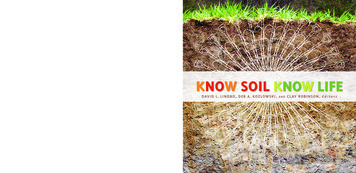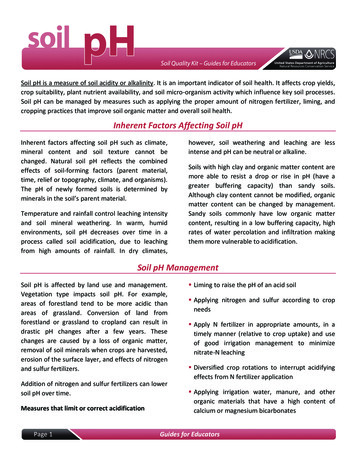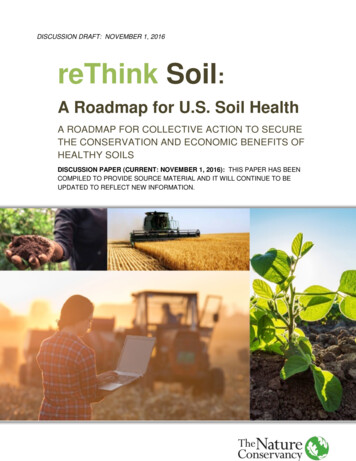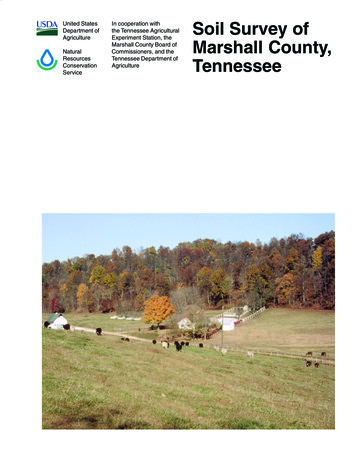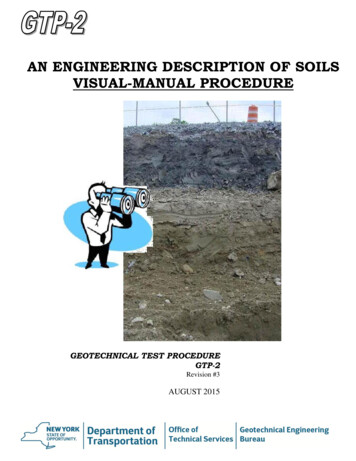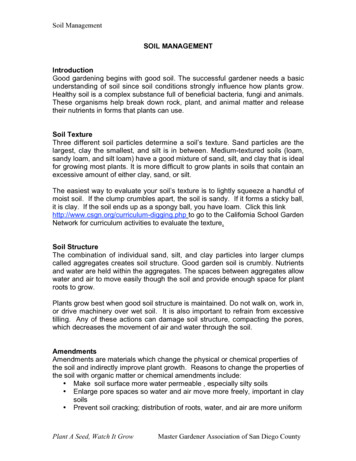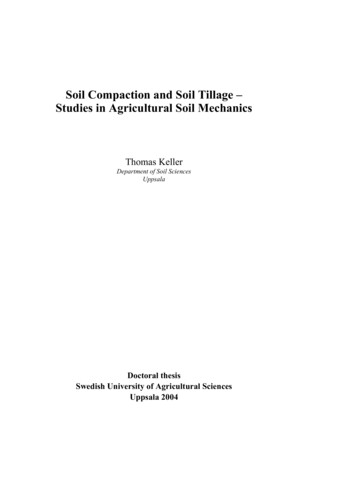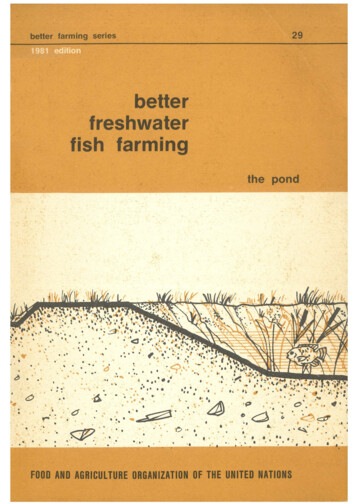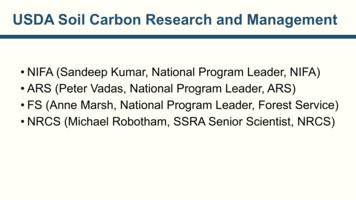
Transcription
USDA Soil Carbon Research and Management NIFA (Sandeep Kumar, National Program Leader, NIFA) ARS (Peter Vadas, National Program Leader, ARS) FS (Anne Marsh, National Program Leader, Forest Service) NRCS (Michael Robotham, SSRA Senior Scientist, NRCS)
AFRI grants support Research, Education and Extensionactivities in 6 Farm Bill priority areas:1.2.3.4.5.6.Plant health and production, and plant productsAnimal health and production, and animal productsFood safety, nutrition, and healthBioenergy, natural resources, and environmentAgriculture systems and technologyAgriculture economics and rural communities
Agriculture & Food Research InitiativeThree Requests for Applications (RFAs)1. Foundational and Applied Science2. Education and Workforce Development3. Sustainable Agricultural Systems
AFRI Grant Types Standard Grants Coordinated Agricultural Projects (CAP) Conference Grants Food and Agriculture Science Enhancement (FASE) Grants New Investigator Grants – two types Strengthening Grants – several types Pre- and Postdoctoral Fellowship Grants
AFRI Programs that support Soil Carbon (C) Soil Health (A1401) Research to advance scientific understanding of soil C, physical and biogeochemical processes and interactions Sustainable Agroecosystems: Health, Functions, Processes and Management (A1451) Crosscutting: Agricultural Microbiomes in Plant Systems and Natural Resources (A1402) molecular mechanisms and signal exchange involved in microbiome assembly and interactions in various environments(e.g., stress, diseases or growth stages), and microbial processes helps in enhancing soil C and health Crosscutting: Critical Agricultural Research and Extension (A1701) a clear, time-sensitive, stakeholder-identified need or problem for agriculture; enhancing soil health (C), nutrientmanagement etc. Crosscutting: Climate Hub Partnerships (A1721) address climate change through improved practices, managing emissions and soil C, and others through regionalpartnerships including USDA Climate Hubs and Extension Sustainable Agriculture Systems Larger grants ( 10M) that supports soil (C and other parameters), air and water management using sustainableproduction systems
AFRI Programs that support Soil Carbon (C) Small Business Innovation Research (SBIR) Program SBIR 8.4 Conservation of Natural Resources develop innovative technologies that are developed with the purpose to conserve, monitor, improveand/or protect the quality and/or quantity of natural resources; e.g., soil C, air, water and nutrientmanagement. Sustainable Agriculture Research and Education (SARE) Regional program with four Host Institutions. Each institution runs several grant programs to: Maintain and enhance the quality and productivity of the soil; Conserve soil, water, energy,natural resources, and fish and wildlife habitat; Maintain and enhance the quality of surfaceand ground water; Protect the health and safety of persons involved in the food and farmsystem; Promote the well-being of animals; and Increase employment opportunities inagriculture Organic Agriculture Program Farm of the Future
USDA-ARS: Highlights 90 research locations,including overseas labs 2000 scientists 660 research projects in 15National Programs 1.5 billion annual budget
Nutrition, Food Safety/Quality Human Nutrition Food Safety Product Quality and New UsesAnimal Production and Protection Food Animal Production Animal Health Veterinary, Medical, and Urban Entomology AquacultureCrop National ResearchProgramsProduction and ProtectionPlant Genetic Resources, Genomics and Genetic ImprovementPlant DiseasesCrop Protection and QuarantineCrop ProductionNatural Resources and Sustainable Agricultural Systems Water Availability and Watershed Management Soil and Air Grass, Forage, and Rangeland Agroecosystems Sustainable Agricultural Systems Research
Comprehensive Approach to Climate Research:Adaptation and Mitigation Resilience to climate andweather extremes (Adaptation) Minimize GHG emissions(Mitigation) Manage Carbon and Bio-Energy(Mitigation) Measure, monitor, verify Systems analysis
Soil CarbonCycleRespirationCO2 captureby plants Maximize inputsresistant to decayManure Minimize losses Stack ocharsErosion
Maximize Inputs Cover crops, living mulch, perennials Soil amendments Silvopasture, agroforestry Breed crops for greater and deeper root biomass
Minimize LossesSoil Microbiome Understand how GxExM impactsmicrobiomes Analytical techniques to identify andquantify microbes and their role Plant-ecotype dynamics that optimizeproductivity and soil C Optimize soil amendments formicrobiomes Reduce tillage Minimize wildfires Prevent soil erosion Land restoration
System Models and NationalGreenhouse InventoryMeasure at different scales formany practices and settings(GRACEnet, REAP, LTAR)Databases(AgCROS)Models to calculateGHG fluxes, C(DayCent)National GreenhouseInventoryNational Resource Inventory
NRCS and FPAC Activities related to Soil CarbonMichael Robotham, SSRA Senior Scientist, NRCS2022USDA-DOE Carbon WorkshopMarch28,
Ongoing Programs / Activities Current data collection efforts Current modeling support efforts Activities under discussion Dynamic Soil Properties for Soil Health (#DSP4SH) - NRCSSoil Health On Farm Conservation Innovation Trials (SH-OFCIT) – NRCSConservation Reserve Program Monitoring, Assessment and Evaluation (CRP-MAE) –FSACOMET-Farm and COMET-Planner – NRCS, Colorado State UniversityConservation Effects Assessment Project (CEAP) – NRCS, ARS, Texas A&MSoil carbon monitoring and assessment network – tied to Soil Survey and NRISoil carbon data collection and assessment under EQIP (Farm Bill) authorities
Partnerships for Climate-Smart Commodities New program – announced by Sec. Vilsack on 2/7Up to 1 Billion allocated funds from Commodity Credit CorporationPilot projects working with ag/forestry producers to: Implement climate-smart production practices, activities, and systems on workinglandsMeasure/quantify, monitor and verify the carbon and greenhouse gas (GHG) benefitsassociated with those practicesDevelop markets and promote the resulting climate-smart commodities Two funding pools More information at: rt-commodities April 8, 2022: ( 5M - 100M)May 27, 2022: ( 250,000 to 4,999,999) – focus on historically underserved groups
Questions/Comments? Sandeep Kumar (Sandeep.Kumar@USDA.gov), National Program Leader, NIFA Peter Vadas (Peter.Vadas@USDA.gov), National Program Leader Anne Marsh (Anne.Marsh@USDA.gov), National Program Leader, Forest Service Michael Robotham (Michael.Robotham@USDA.gov), SSRA Senior Scientist, NRCS
Veterinary, Medical, and Urban Entomology . Greenhouse Inventory. Measure at different scales for many practices and settings (GRACEnet, REAP, LTAR) Databases . U.S. Department of Agriculture Soil Carbon Research and Management presentation by Sandeep Kumar, Peter Vadas, Anne Marsh, Michael Robotham, USDA, at the Bioenergy's Role in Soil .
